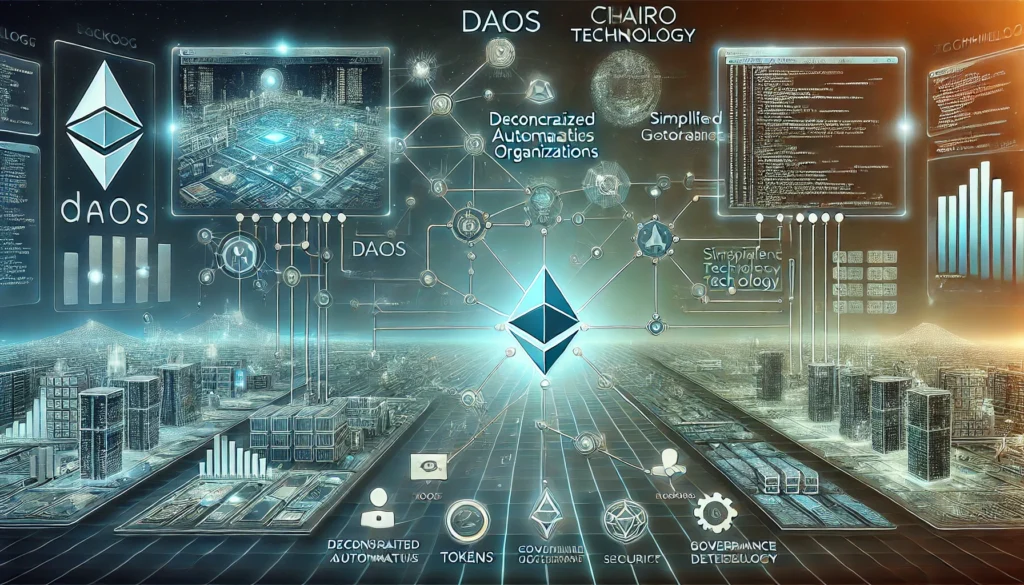In the ever-evolving landscape of blockchain technology, innovative concepts continue to redefine how we interact with digital ecosystems. Two such groundbreaking advancements are Decentralized Autonomous Organizations DAO vs Chiaro Technology. While both aim to enhance blockchain efficiency, their purposes, architectures, and applications differ significantly. This article delves deep into their comparison, exploring their potential, challenges, and opportunities for synergy.
1. What Are DAOs?
Decentralized Autonomous Organizations (DAOs) are blockchain-based entities governed by smart contracts rather than centralized authorities. They represent a revolutionary way of organizing collective decision-making and financial management.
Core Principles of DAOs:
- Decentralization: Power is distributed among members rather than a central figure or entity.
- Autonomy: Smart contracts govern processes, ensuring operations without manual intervention.
- Transparency: All activities, decisions, and financial flows are visible on the blockchain.
Key Features:
- Smart Contract-Based Governance: DAOs operate via predefined rules encoded into smart contracts, which execute automatically based on member inputs.
- Tokenized Voting Systems: Members use governance tokens to participate in decision-making processes.
- Global Accessibility: Anyone with an internet connection can join and contribute.
Applications of DAOs:
- Finance: Projects like MakerDAO manage decentralized stablecoins and lending platforms.
- Gaming: Platforms like Decentraland allow users to govern virtual economies.
- Supply Chains: DAOs streamline decision-making across decentralized logistics networks.
Advantages:
- Decentralized Decision-Making: Ensures equitable power distribution.
- Transparency: Activities are recorded on immutable ledgers.
- Trustless Environment: Smart contracts eliminate the need for intermediaries.
Challenges:
- Legal Ambiguity: DAOs often face unclear regulatory environments.
- Smart Contract Vulnerabilities: Errors in code can lead to exploitation.
- Consensus Bottlenecks: Achieving majority agreement can be slow.
2. Overview of Chiaro Technology
Chiaro Technology represents a new paradigm in blockchain transparency and usability. Unlike DAOs, which focus on governance, Chiaro aims to simplify blockchain operations while maintaining clarity in code and functionality.
Key Features:
- Enhanced Transparency: Chiaro Technology provides clearer, more readable code to promote trust.
- Advanced Security Measures: By reducing code obfuscation, it minimizes vulnerabilities.
- User-Friendly Design: Focuses on bridging the gap between technical complexities and usability.
Applications:
- Smart Contract Optimization: Simplifying execution processes.
- Blockchain Usability Enhancements: Making blockchain interactions intuitive for non-technical users.
Strengths of Chiaro Technology:
- Improved Security: Clear code reduces the risk of exploits.
- Efficient Development: Developers can create and audit blockchain applications more effectively.
- Transparency in Operations: Promotes greater trust among users.
Limitations:
- Integration Challenges: Compatibility with existing systems may require significant adjustments.
- Adoption Barriers: Its novelty means slower adoption in traditional blockchain environments.
3. DAO vs Chiaro Technology: Key Comparisons
Philosophy and Purpose:
- DAOs: Prioritize decentralized governance and collective decision-making.
- Chiaro Technology: Focuses on transparency and operational efficiency within blockchain applications.
Technical Foundations:
- DAOs: Operate on smart contracts, relying on tokenized governance mechanisms.
- Chiaro Technology: Leverages simplified and transparent coding structures for better functionality.
Adoption and Applications:
- DAOs: Popular in community-driven projects, including DeFi platforms and decentralized gaming.
- Chiaro Technology: More suitable for enhancing existing blockchain operations and usability.
Security Considerations:
- DAOs: Vulnerable to smart contract exploits and governance manipulation.
- Chiaro Technology: Reduces vulnerabilities by emphasizing clear, auditable code.
4. Use Cases and Real-World Implementations
Examples of Successful DAOs:
- MakerDAO: A pioneer in decentralized lending and stablecoin issuance.
- Uniswap DAO: Governs one of the largest decentralized exchanges in the world.
- Aragon: Provides tools for creating and managing DAOs.
Chiaro Technology Applications:
- Smart Contract Security: Improving code clarity to prevent exploits.
- Blockchain Transparency: Used in projects requiring high levels of trust and accountability, such as public sector applications.
Comparative Effectiveness
5. Potential Synergies
Although DAOs and Chiaro Technology differ in purpose, their integration could offer significant benefits:
- Improved DAO Governance: Chiaro Technology could enhance transparency in DAO decision-making processes, reducing conflicts and promoting trust.
- Enhanced Smart Contracts: DAOs could leverage Chiaro’s simplified coding frameworks to minimize vulnerabilities and improve security.
- Broader Adoption: Combining the usability of Chiaro with the decentralized ethos of DAOs could make blockchain more accessible to mainstream users.
6. Challenges and Future Directions
Challenges:
- Legal and Regulatory Hurdles: Both DAOs and Chiaro face uncertainties in legal recognition and compliance.
- Scalability Issues: DAOs struggle with consensus bottlenecks, while Chiaro Technology requires widespread adoption to realize its full potential.
- Interoperability: Integrating these technologies with existing blockchain systems may pose technical challenges.
Future Directions:
- DAOs: Greater regulatory clarity and advancements in Layer 2 scaling solutions will enhance their usability.
- Chiaro Technology: Broader adoption in DeFi and public sector projects could accelerate its growth.
- Synergies: Collaborative efforts between DAOs and Chiaro could revolutionize decentralized ecosystems.
7. FAQs About DAO vs Chiaro Technology
1. What is the primary difference between DAOs and Chiaro Technology?
DAOs focus on decentralized governance and decision-making, while Chiaro Technology emphasizes transparency and operational efficiency in blockchain applications.
2. Can DAOs use Chiaro Technology?
Yes, DAOs can integrate Chiaro Technology to improve transparency and security in their smart contract operations.
3. What industries benefit most from DAOs?
Industries such as finance, gaming, and supply chain management are leveraging DAOs for decentralized decision-making and operational efficiency.
4. Is Chiaro Technology widely adopted?
Chiaro Technology is still emerging but has significant potential in sectors requiring high transparency and secure blockchain interactions.
5. Which is better: DAO or Chiaro Technology?
Both have distinct purposes. DAOs excel in community-driven governance, while Chiaro Technology shines in enhancing blockchain usability and transparency.
Conclusion – DAO vs Chiaro Technology
DAO vs Chiaro Technology are two transformative innovations in the blockchain world. While DAOs empower decentralized governance, Chiaro Technology brings clarity and usability to blockchain operations. Together, they offer complementary solutions that could drive the next wave of blockchain adoption. As the blockchain ecosystem evolves, understanding and leveraging these technologies will be critical for anyone looking to thrive in this decentralized future.
